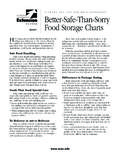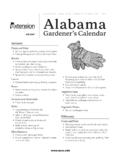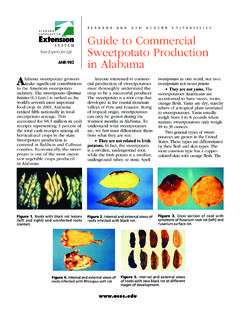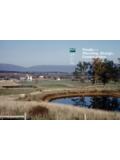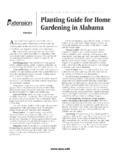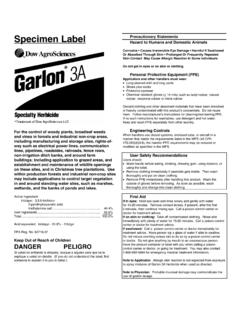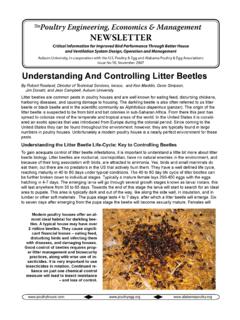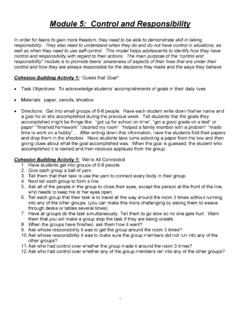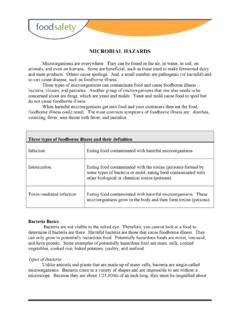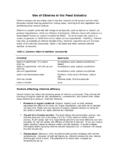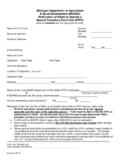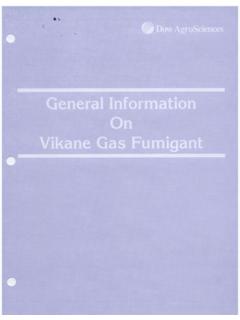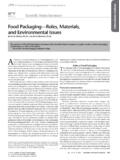Transcription of Medicated Feed for Food Fish - ACES.edu
1 Bacteria are tiny, single-celled or-ganisms which are continuallypresent in the water, soil, and bacteria are beneficial ( ,they help digest foods and breakdown ammonia, nitrite, andorganic debris in the environ-ment). There are a number of dif-ferent bacteria that cause diseasein cultured freshwater food fishsuch as catfish, salmon, and aquaculture, many bacterialdiseases of fish can be successfullytreated with Medicated , preventionthroughgood management practices is thebest control measure for diseases of fish are usu-ally a result of stress such as over-crowding.
2 Avoiding these stres-sors often reduces disease inci-dence. Failing to correct stressfulconditions while treating sick fishwith Medicated feed will usuallyeither prevent the medicationfrom being effective or will causethe disease to recur after the treat-ment is diseaseSome bacteria are considered op-portunistic pathogens. These bac-teria are often present in the waterand inside the fish , and they usu-ally cause no problem. In naturefish are, in most cases, resistant tothese pathogens and can seek thebest living conditions aquaculture, however, food fishare weakened by stress conditionsincluding increased fish density,inadequate nutrition, poor waterquality ( , low dissolved oxy-gen, or high ammonia and nitrite),parasite infestation, and suppresses the immune sys-tem, increasing the fish s suscepti-bility to bacterial infections.
3 As aresult, cultured food fish are moresusceptible to disease than free-ranging animals. Common exam-ples of opportunistic bacteriawhich can cause disease anddeath of food fish include:Aeromonas hydrophila, Cytophaga(Flexibacter) columnaris, andPseudomonas bacteria are considered obli-gate pathogens. They can be thesole cause of disease even in theabsence of stressors. Aeromonassalmonicida, Edwardsiella ictaluri,Renibacterium salmoninarum,andYersinia ruckeriare considered bysome to be obligate feedMedicated feed is frequently re-commended to control bacterialdisease outbreaks.
4 Medicatedfeeds contain an antibiotic and areusually commercially are drugs that can betaken internally to control bacteri-al infections. They do not controlparasites, fungus, or viruses. Fishoften stop eating as a bacterialdisease progresses, so early diag-nosis and treatment are essentialto ensure that infected fish con-sume the Medicated feed . Once abacterial disease is detected, and ifmedicated feed is the appropriatetreatment, the feed should be Medicated feed is not readilyavailable in your area, it may beadvisable to special order a fewbags to keep on hand, stored in acool, dry place.
5 Delivery of feedmay take a few days to more thana week, which will delay treat-ment and jeopardize the health ofthe fish . There are many different types ofantibiotics, but the food and DrugAdministration (FDA) hasVIPRJuly 1996(Revised)SRAC Publication No. 473 Medicated feed For food FishRobert M. Durborow1and Ruth Francis-Floyd21 Kentucky State of food and AgriculturalSciences, University of only two for use infood fish . These are Terramycin (Pfizer, Animal HealthOperations, New York, NY) andRomet (Hoffman-LaRoche, Inc.,Nutley, NJ). Older literature listsSulfamerazine for the treatmentof diseased fish , but it is nolonger available.
6 Each is dis-cussed separately Terramycin has been used fortreatment of food fish for manyyears. It contains the drug oxytet-racycline. This drug is usuallyeffective against many bacteriawhich cause disease in food FDA specifically approvedTerramycin for control ofAeromonas hydrophila (A. liquefa-ciens)and Pseudomonassp. infec-tions in catfish and Aeromonassalmonicida, A. salmonicida achro-mogens (Haemophilus piscium), (A. liquefaciens)andPseudomonas sp. in trout. motileaeromonas septicemia, A. salmoni-cidacauses furunculosis, and achromogenscausesulcerative disease in trout andgoldfish.
7 Terramycin is incorpo-rated into the feed by commercialmills and fed at a rate of (g) of the drug per 100pounds of fish per must be fed for 10days to control the infection. Thefish must be held for an addition-al 21 days before they can be mar-keted for food to allow completeelimination of the drug from thefish. Marketing fish for humanconsumption before the end of the21-day withdrawal periodis aviolation of federal law. As aresult, marketing plans must beconsidered before treating fishwith Terramycin . Once treated, fish cannot be sold for at least 31days (10-day treatment periodplus 21-day withdrawal period).
8 An additional consideration whenfeeding Terramycin is that it isonly available from commercialmills as a sinking feed . The drugis broken down by the highertemperatures needed to make anextruded (floating) pellet. Feedinga sinking food is a major disad-vantage for sick pond fish becauseit is difficult to determine if theyare eating the Medicated feed . Romet Romet (Romet-30 , Romet-B ) isalso approved for use in bothtrout and catfish as well as insalmon. This product contains twodrugs, sulfadimethoxineandormetoprim. These drugs in com-bination are more effective thaneither drug used alone.
9 Romet isspecifically approved for treat-ment of Edwardsiella ictaluri infec-tions in catfish and Aeromonassalmonicidainfections in trout andsalmon. E. ictaluricauses entericsepticemia of Medicated feed is pro-duced by commercial feed millsand should be fed at a dosage of23 milligrams (mg) of drug perpound of fish (50 mg of drug perkilogram of fish ) per day for 5days. If the feed contains of Romet-30 premix perton, then the fish need to consumeat least 1 percent of their bodyweight to achieve a therapeuticdose of the drug. At varyingRomet concentrations, the prop-er feeding rate can easily be calcu-lated.
10 For example, feed mixedwith pounds of Romet-30 per ton of feed should be fed at 3percent of body withdrawal period forRomet is only 3 days for channelcatfish. This is considerably lessthan for Terramycin . With a 5-day treatment period and a 3-daywithdrawal period, catfish treatedwith Romet can be slaughteredonly eight days after the drugtreatment is initiated. Trout, how-ever, are required to have a 42-daywithdrawal period from Romet before being advantage of Romet isits availability from commercialmills in a floating pellet. Thisallows direct pond observation ofthe fish eating the Medicated the propermedicationTo optimize the response toantibiotics provided in feed , pro-ducers should correct other prob-lems which may have predis-posed fish to the bacterial infec-tion.
